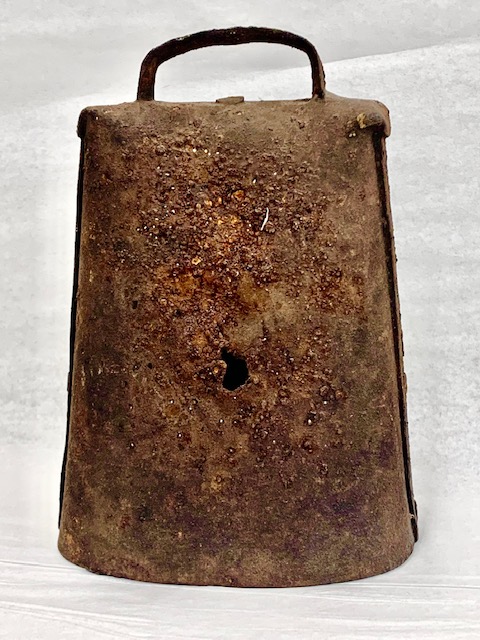By Heather Hembrey, M.A., M.A.A.

A cow wore this bell as she grazed at Sully Historic Site in Chantilly. The bell is six inches high and made from an iron sheet that was bent and riveted into shape, most likely during the early 20th century. The cow and others in her herd wore bells around their necks so their owner could locate them in open pastures. These cows produced the milk that spurred Fairfax County’s dairy industry.
Nearly every 18th-century farmstead included at least one “milch” cow. Farm families depended on cows to provide milk from which they made cheese and butter for themselves or to sell locally. Large-scale farmers maintained more cows to supply dairy products for their residents.
In 1840, the U.S. Government first published farm product statistics in its decennial Agriculture Schedule. Statistics on cows and dairy products between 1850 and 1900 demonstrate the growth of Fairfax County’s dairy industry during those years. From 1850 to 1870, only milch cows were enumerated and the number of cows in Fairfax County increased from 3,363 to 5,305. Beginning in 1880 the Schedules included data on dairy products as well as cows. The number of dairy cows peaked at 7,236 in 1890; that’s a lot of bells if each cow wore one. Gallons of milk and cream produced, and pounds of butter made for home use and sale were also tabulated. In 1899, the dairy cows living on 1,398 Fairfax County farms produced over three point three million gallons of milk.
Railroads spurred the county’s move from grains to dairy. Wheat shipped from the Midwest was less expensive than wheat grown and processed in Fairfax County, so fewer farmers invested in the crop and instead turned to dairy production. In 1879, 515,537 gallons of Fairfax County milk were shipped by rail to butter and cheese factories in Washington, D.C. and beyond. The Maryland and Virginia Dairy Milk Producers’ Association was founded in 1920, while the Fairfax Herald newspaper regularly offered advice on cows and dairy production.
Today, visitors can visit some Fairfax County parks to explore our dairy history. Features of the 19th-century Walney Dairy are visible at Ellanor C. Lawrence Park in Chantilly. Frying Pan Farm Park in Herndon is home to many animals, including cows who are milked every day.

